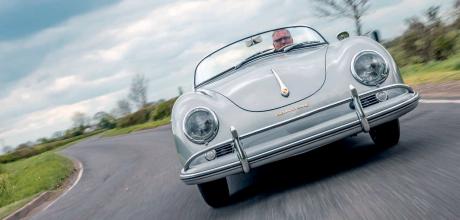1957 Porsche 356 A T2 Speedster
This 1957 Porsche 356 A T2 Speedster has survived near seven decades without a single dink, dent or any impact damage, resulting in an unrestored body the like we’re unlikely to witness again...
Words Dan Furr
Photography Dan Sherwood
AUTHENTIC SELF TRUE SURVIVOR
UNRESTORED 1957 356 A T2 SPEEDSTER - A pristine 1957 356 A T2 Speedster.
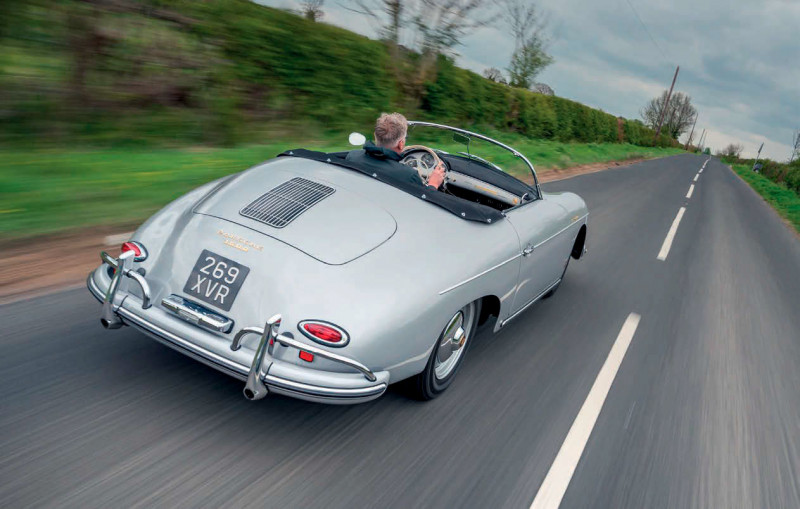
It’s easy to consider the 356 a rare thing, but as this magazine demonstrates time and again, a high number of the near seventy-six thousand examples of Porsche’s first production car have survived to the present day. Granted, the condition of these air-cooled relics of a bygone motoring age ranges from derelict doer-upper to concours trophy winner, but whether hot rod, road rat, show queen or rust bucket, all are afforded near universal appreciation, not only for their role in establishing Porsche as a volume producer of high-quality sports cars, but also for serving as the foundation on which the evergreen 911 was built.
WE’RE SIMPLY IN THE PRESENCE OF ONE OF THE MOST ORIGINAL SPEEDSTERS ANYWHERE IN THE WORLD
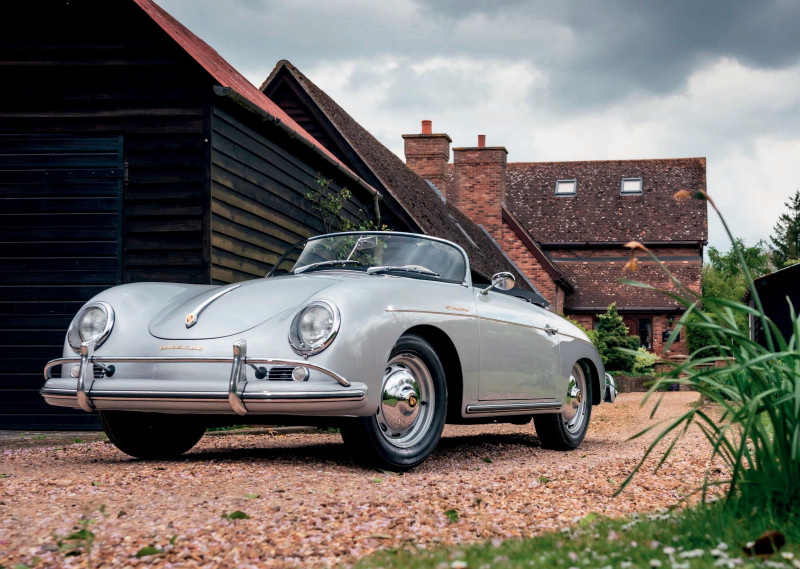
Compared to the standard of manufacturing applied to many similarly aged premium marque performance vehicles, such as those from Aston Martin and Jaguar, as well as various Italian brands, the quality of engineering and construction rolling out of Porsche was second to none. This is, of course, is a tradition extending all the way through the company’s product line, from 356 no.1 to the very latest GT offerings from Zuffenhausen. It’s also the primary reason so many 356s continue to be used regularly, despite the newest example fast approaching its seventieth anniversary and, it must be said, in spite of the low value of these Porsches during decades past, when many of the 356’s contemporaries were sent to the great scrapyard in the sky, their continued operation proving prohibitively expensive.
AN ALTOGETHER DIFFERENT KIND OF 356 SPEEDSTER TO THE PROJECT CARS WILLHOIT IS RECOGNISED FOR
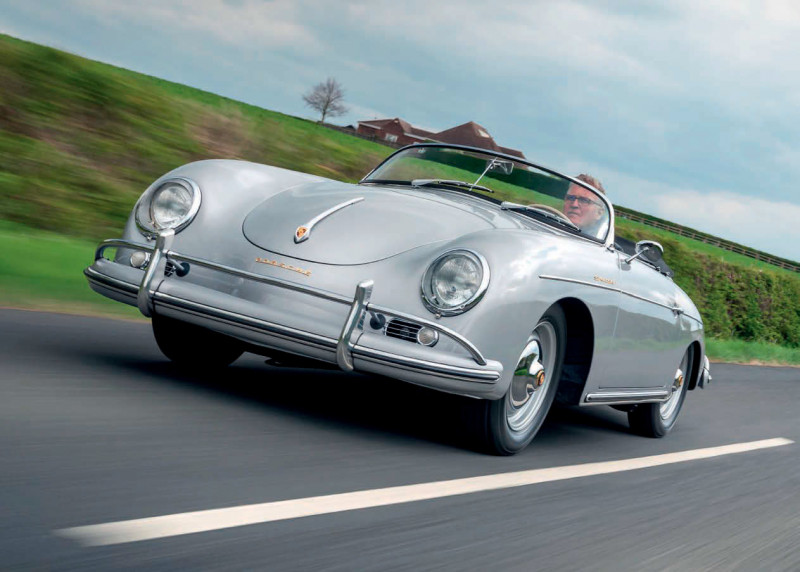
TRICK OF THE LIGHT
Porsche’s no-compromise approach to vehicle assembly is one of the reasons restoration of a 356 is such a complex task — it’s easy to underestimate the significant cost and time it takes to properly rectify a corroded 356 body. Some owners consider acquiring a 356 from California as a workaround, as though all vehicles residing in The Golden State — nicknamed primarily in recognition of its fields of golden poppies and the discovery of vast reserves of gold, rather than being credited for its tourist-friendly sunshine — remain in ‘as new’ condition irrespective of their age. Obviously, this is a nonsense. Granted, the West Coast’s warm climate offers old metal a fighting chance of keeping corrosion at bay, but salt in the air as a consequence of being next to the Pacific Ocean brings a different threat to vintage vehicles in California. Also, last time I checked, the West Coast doesn’t act as a barrier to accident damage and poorly executed repair work. Needless to say, I’ve lost count of the number of air-cooled Porsches I’ve seen arrive in the UK after being bought unseen by buyers confident many years of Californian registration somehow equates to a stamp of approval, only for the car to be a complete basket case when extracted from its shipping container in Blighty. Long story short, outside of full restoration, finding a solid, original air-cooled Porsche is something of a rarity.
All of which leads us neatly to the 1957 Porsche 356 A T2 Speedster you see on the pages before you. Beautiful, isn’t it? Anyone would think this shimmering silver droptop had been comprehensively restored, such is its immaculate presentation. Not so, as I discovered on a recent trip to Bedfordshire-based independent Porsche sales and restoration specialist, Export 56.
Delivered new to Max Hoffman’s New York-based European sports car dealership in Autumn 1957 (for the 1958 model year), this al fresco 356 is, as alluded to in the opening sentence of this article, hardly what you should regard as a rare model — from launch to the end of production in late 1958, Porsche manufactured in excess of 3,600 356 Speedsters. 1,171 of them were built in 1957 alone. Getting hold of a Speedster today is therefore a straightforward affair, the only barrier to ownership being the depth of your pockets. What are you getting for your money, though?
Let’s face it, most presentable Speedsters have been restored — there is an argument the buyer is exchanging their cash for what is essentially a new car. New metal, new parts, all in the shape of an old Porsche. Decide your preferred colour, engine and trim combination, then take your pick from a market showing no sign of slowing, despite the economic uncertainty we face right now. What could be simpler?
Well, what if you wanted to own a truly original 356 Speedster? No restoration, no accident damage. A tall order, for sure. After all, the Speedster was a car designed for the US market at the behest of the aforementioned Hoffman, who wanted Porsche to create a fuss-free, stripped-down roadster with a short, low-rake windscreen and basic bucket seats suited to North America’s burgeoning club racing scene, something Hoffman recognised as being a potentially lucrative sales arena. In other words, 356 Speedsters were cars subjected to hard racing and hard knocks. At one time, they were also the cheapest Porsche products going. No frills, many thrills, often at the expense of the cars themselves.
And yet, here we are in Cranfield, in the presence of a true survivor. No corrective bodywork, no chequered history. The 356 Speedster might not be a rare Porsche, but an example in this unrestored condition? A very rare thing indeed. In addition to the sale and restoration of historically significant Porsches, Export 56 curates collections of cars for discerning buyers. These carefully selected assortments of air-cooled classics feature some of the very best race and road cars to carry the Stuttgart crest. Regular readers will know prime selections from the Export 56 fold have made their way onto these pages. “We took on a new client who wanted to build a collection of classic Porsches,” company founder, Mick Pacey, explains. “He’d included a 356 Speedster on his wish list, along with a Carrera GT and a Carrera RS 2.7 in Touring specification. I reached out to my contacts in the USA and expressed interest in bringing a Speedster in respectable condition to the UK.”
Mick was told, almost in passing, about a Speedster enjoying attention at Willhoit Auto Restoration, the famed 356, 912 and early 911 restoration company in operation since the mid-1970s. Based in a 14,000ft2 facility in Long Beach, California, Willhoit’s stable has turned out some of the world’s most celebrated restored air-cooled Porsches, many of them fixtures of the winner’s circle at Porsche concours events. Under the rule of company boss, John Willhoit, all work is performed to an extraordinarily high standard, his aim being to ensure the Porsches his team produce are not only stunning in appearance, but also hugely enjoyable to drive and use, just as the manufacturer intended.
The 356 Mick was being told about was an altogether different kind of Speedster to the project cars Willhoit is recognised for. Not only was it a late model finished in a rare-for-the-T2 lick of silver, but it was also in near immaculate unrestored condition. Willhoit, so Mick was told, had been tasked with giving the car’s mechanicals an overhaul, but the body required no attention. This was music to his ears — a 356 boasting factory originality on this scale is virtually unheard of. He’d found the perfect Speedster to kickstart his client’s collection.
DUTY OF CARE
What contributed to this pretty Porsche’s preservation? Was it a museum piece? “Not at all,” Mick continues. “It had simply led a really good life in single-family ownership and had very little use since its original point of purchase from Hoffman, only coming out for the occasional sunny drive. So many Speedsters were wrecked in club racing or ended up with battered-around bodies, especially in the 1980s, when the value of these cars was at rock bottom. Weird modifications and bad repair work were commonplace back then. In contrast, this car was extremely well looked after, leading it to arrive at the Willhoit workshop for a timely overhaul of its drivetrain and running gear, rather than because it needed repair or corrective metalwork, as is so often the case with 356 Speedsters.”
Willhoit — “staggeringly good work,” attests Mick, before telling us the Willhoit name carries a premium worth shelling out for when considering the purchase of a Porsche which has been worked on by the company’s team of technicians — took care of refreshing the 1.6- litre flat-four, its accompanying transmission, brakes and the suspension, all of it numbers-matched. An inspection of the car as a whole reported no sign of accident damage. “Quite remarkable,” Mick concedes. “Willhoit confirmed there was no sign of impact, nor rot or rust anywhere on the car. It really is rare to find a Porsche of this era in such amazing unrestored condition, especially when you consider the manufacturer makes its cars so drivable, a quality which encourages owners to hit the road at every available opportunity.” Even so, the silverstunner has seen little action, though this isn’t to say it didn’t need any cosmetic work, as Mick explains.
“I negotiated purchase of the car after being made aware of the fact it was subjected to a paint job many decades ago. It wasn’t a brilliantly executed respray, but it was true to the factory colour, which was applied to only a handful of late Speedsters. If the original paint was in place, I’m sure my client would have liked us to retain the patina it would have displayed, but because the respray was showing signs of slight blistering many years after application, he instructed us to strip his new 356 and give it a fresh coat of colour matching the original silver.”
After the car completed its journey across The Pond and landed at Export 56, Mick’s team began the weeks long process of disassembly, including the laborious job of hand-stripping the offending paintwork. “I was staggered at the excellent condition of the body beneath,” he gasps. “Over the years, I’ve seen 356s in all conditions, from run-down to restored, but it’s awfully unusual to find one completely free of body damage, let alone a Speedster as near perfect as this. I was looking at metalwork nothing short of spectacular — no welding, no corrosion, perfect factory panel gaps, all the trim holes exactly as they left the factory, plus original lead work just as it was applied by Porsche.”
THE HOLY GRAIL
There was slight discolouration where moisture had been trapped beneath side trim sill rubber many moons ago — the parts are meant to protect metal, but can have the opposite effect — but this was really all Export 56 could find fault with. Doors, engine lid, the ‘frunk’, all of it was pristine. “In all my years working on these cars, I’ve never seen one this good. Some owners like to preserve their classic Porsches, rather than restore them, but when you pull them apart, smacks, dinks and dents soon make themselves known and restoration work begins. There was absolutely nothing of the sort when we inspected this Speedster post-strip. It required no panel beating whatsoever. A remarkable find.”
Many surviving premium sports cars of this era have a strong story to tell. Celebrity ownership, the first (and, perhaps, only) of a particular specification, mind-boggling restoration. These are all familiar themes to readers of motoring magazines like ours. No such tales are carried by this 356, though. We’re simply in the presence of one of the most original Speedsters anywhere in the world. The fact it is now wearing its second respray (expertly applied this time around, I might add) in almost seventy years does nothing to detract from how sensational this Porsche really is. “There’s an argument the body would have looked great in bare metal, lacquered to show just how unusually well preserved it is,” laughs Mick. “It’s not my car, though!” The customer is always right, as the say.
The interior of the Porsche has been given a lift with new carpets and, as the keen eyed among you will have noted, leather-trimmed buckets with corduroy centres. The original leatherette-covered Porsche pews were removed and put to one side to ensure their preservation long into the future. The dash top and door cards are trimmed in leather at owner request.
The Willhoit-serviced engine, gearbox and running gear have delivered a Speedster driving amazingly well. It’s an easy 356 to get to grips with, feeling light and very fleet of foot. Naturally, all Speedsters share common on-the-road characteristics, but as is the case with all Porsche models, evolution of the species between 1954 and discontinuation four years later brought improvements in build quality and mechanical technology, meaning a late 356 Speedster is the best of breed in stock form. Willhoit’s work in beautifully setting up this air-cooled Porsche’s engine, brakes, suspension and steering has reintroduced lost responsiveness, ensuring the new owner will get just as much enjoyment from driving the car as he will staring at its immaculately presented, amazingly unrestored body. And what a body it is!
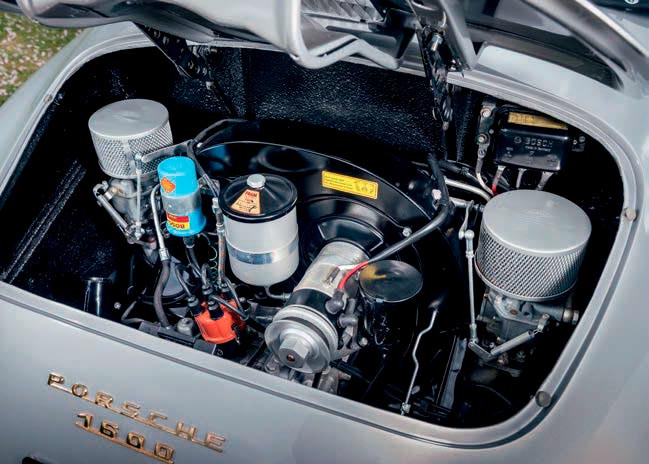
Above Thanks to Willhoit’s work on the oily bits, this stunning Speedster drives brilliantly and will be put to good use by its new owner. Above Most Speedsters in this presentation would have been subjected to hundreds of hours of body restoration, but not our star car. Above The car’s numbers-matching engine, gearbox and all running gear was thoroughly overhauled by the team at Willhoit Auto.
Restoration in Long Beach.
Below In single-family ownership for most of its life, this super Speedster revealed an immaculate body when stripped for fresh paint, with no dinks, dents, corrosion or impact damage suffered in the near seventy years since the Porsche was imported to New York by European sports car salesman, Max Hoffman. Above Demand for 356 Speedsters is high right now, but the model is by no means a rarity, meaning there’s plenty of opportunity for you to bag a Speedster to call your own.


